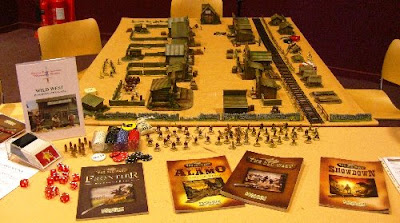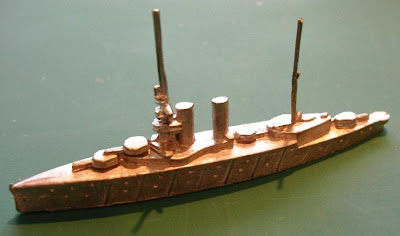Whilst thinking about 20th century imagi-nations I remembered an article that I wrote some time ago for
THE NUGGET (the journal of
Wargame Developments) about what can only be described as a government-approved imagi-nation – Aggressor. The following is a revised version of that article, and it provides enough background information for anyone who might want to base their own 20th century imagi-nation on a 'real' imagi-nation.
Introduction
The Aggressor concept came about because of the Cold War. The US Army’s existing training films were either out-of-date or showed the Germans or Japanese as the ‘enemy’. Genuine uniforms and equipment used by the main potential enemies that the US Army would face were almost impossible to obtain. The result was Aggressor.
The Aggressor army were not just standard US Army units dressed in different uniforms. A complete background
raison d’etre was created for Aggressor; it had a history, a language, and a flag as well as its own tactical doctrine.
The history of AggressorThe chaotic conditions in Western Europe, which had resulted from major disagreements between the victorious allies as well as the failure of the United Nations Organization, led to the creation of a new nation, Aggressor. A small group of ruthless and determined men who were committed to the concept of a totalitarian nation-state formed a political party – the Circle Trigon Party. It took over the control of the weakened Spanish government, and established the Aggressor Republic.

Once it had consolidated its control of Spain and Spanish Morocco, it began to infiltrate political activists, agitators, and
argent provocateurs into neighbouring countries. It coupled this with a robust propaganda campaign aimed at its neighbours. This emphasised the need for political unity and strong government in the current uncertain political climate.
This message was well received in southern France, northern Italy, Bavaria, and the Tyrol, where United States occupation forces were weak or non-existent. Strong secessionist movements quickly grew in these areas, fuelled by money, arms, and political support from Aggressor. The weakened governments of France and Italy and the occupying Power proved powerless in the face of increasing calls for self-determination, and after a series of short but violent uprisings in early 1946, these areas gained independence. Their new governments were all led by Aggressor sympathisers and immediately requested union with Aggressor, which was granted.
Having secured a powerbase, the leaders of Aggressor concentrated their attention upon improving the economy of their new nation. In parallel with this campaign the country underwent a period of intense political reorganisation and re-education. The result of these initiatives was national unity and economic self-sufficiency, and by the late 1940s Aggressor felt able to deal with what it perceived to be its main enemy – the United States.
Map of Aggressor 
Population of AggressorBy the end of the 1940s the population of Aggressor had reached 110,000,000. In addition the government encouraged suitable immigrants and displaced persons from other European nations to settle there. In particular scientists, soldiers, and professional men of all types were encouraged to emigrate to Aggressor, and they were afforded preferential treatment when they arrived in their new home.
In addition a variety of strategies were adopted to increase the population by raising the normal birth rate. This included offering bounties to families who had more than three children. A result of these policies was a rapid growth in the population, which in turn made territorial expansion a necessity.
The language and religion of AggressorAt first Spanish was adopted as the official language, although French, Italian, and German were still spoken in the eastern provinces. However, as part of the campaign to develop a unified nation it was decided to adopt Esperanto as the official language. All Aggressor personnel were expected to speak Esperanto whenever possible, although total fluency was not common, and English was an acceptable alternative.
There was no state religion in Aggressor and the population enjoyed complete religious freedom. This policy had the distinct advantage of not antagonizing or alienating any religious group.
Example of Aggressor vehicle markings 
M41 Tank showing the position of the Aggressor vehicle marking
Aggressor uniformsThe uniforms worn by Aggressor were similar in style and cut to those worn by the contemporary US Army, but with several subtle but significant changes. The basic uniform colour was Dark Jungle Green, with Olive Drab webbing/Black leather belts and Black boots. The helmet was the same as that used by the US Army but with a distinctive crest running from back to front. This was about 8.5 inches long, 1.5 inches wide, and tapered from 1.5 inches high at the front to 0.5 inches high at the back.
Each branch was indicated by different coloured scarves and collar tabs, and – in the case of NCOs – piping on the outside seam of the combat trousers. Elite units including Fusiliers (the Aggressor equivalent of Soviet Guards units), Airborne, and Armoured also wore coloured Garrison Caps:
- Rifles (including Mechanised, Mountain and Ski troops): Red branch colour, Dark Jungle Green cap
- Fusilier: Red branch colour; Red cap
- Airborne: Blue branch colour; Red cap
- Armoured: Yellow branch colour; Black cap
- Artillery: White branch colour; Dark Jungle Green cap
- Engineers: Green branch colour; Dark Jungle Green cap
- Signal: Tan branch colour; Dark Jungle Green cap
- Chemical: Purple branch colour; Dark Jungle Green cap
- Other services: Orange branch colour; Dark Jungle Green cap
Formations (Divisions, Corps, and Armies) were indicated by rectangular coloured patches worn on the upper right arm.
- Rifles: Red rectangle
- Airborne: Blue rectangle
- Armoured: Yellow rectangle
- Artillery: White rectangle
Officers had coloured shoulder straps that denoted status and/or rank.
- Fusilier: Red shoulder straps
- Airborne: None on shoulder straps
- General: White (with Red edging if Elite) shoulder straps
- All other Officers: Green shoulder straps
Examples of Aggressor uniforms 
Officer of a Fusilier Armoured Reconnaissance Regiment in a Fusilier Tank Army (Yellow collar tabs indicated an armoured unit; red shoulder straps indicate an officer in a Fusilier unit, as does the red Garrison Cap; the yellow arm patch indicates the unit belongs to an armoured formation)

Soldier of a Mechanised Rifle Regiment in a Mechanised Rifle Division (Red collar tabs indicated an Rifles unit; the red arm patch indicates the unit belongs to an Rifle formation)

Officer of a Tank Regiment in a Tank Division (Yellow collar tabs indicated an armoured unit, as does the black Garrison Cap; the yellow arm patch indicates the unit belongs to an armoured formation)

Soldier of an Artillery Regiment in a Mechanised Rifle Division (White collar tabs indicated an artillery unit; the red arm patch indicates the unit belongs to an Rifle formation)

Officer of an Airborne Regiment in a Airborne Division (Blue collar tabs indicated an airborne unit, as does the red Garrison Cap; the blue arm patch indicates the unit belongs to an airborne formation)
Badges of rankRanks were indicated by downward pointing chevrons (some with ‘rockers’ and pips), pips, bars, leaves, and crossed cannon barrels.

1: Senior Private; 2: Corporal; 3: Section Sergeant; 4: Platoon Sergeant; 5: Senior Sergeant; 6: Staff Sergeant; 7: Sergeant Major

A: Warrant Officer; B: Sub Lieutenant; C: Lieutenant; D: Captain; E: Major; F: Commandant; G: Colonel; H: General of Brigade; I: General of Division; J: General of Corps; K: General of Army; L: Marshal
















































































